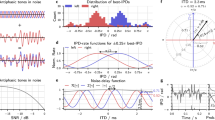Abstract
IT is often assumed in theories of selective attention that dichotic auditory inputs can be considered as separate channels subject to filtering before complete analysis1. But the fact that highly probable or particularly significant items in the “rejected” message are detected and followed2,3 has led to the revision of this “single channel” theory to allow for some degree of analysis of the rejected message4,5. It is also possible, however, that the initial selection takes place on at least two criteria: spatial location of the message (right or left ear) and probability of the item, with high probability of an item overriding spatial location as a determinant of selection.
Similar content being viewed by others
References
Broadbent, D. E., Perception and Communication (Pergamon, London, 1958).
Triesman, A., Amer. J. Psychol., 77, 206 (1964).
Cherry, C., J. Acoust. Soc. Amer., 25, 975 (1953).
Deutsch, J. A., and Deutsch, D., Psychol. Rev., 70, 80 (1963).
Treisman, A., Brit. Med. Bull., 20, 12 (1964).
Palermo, D. S., and Jenkins, J. J., Word Association Norms (University of Minnesota Press, 1964).
Author information
Authors and Affiliations
Rights and permissions
About this article
Cite this article
BLOOMFIELD, T. Single Channel Theory and Dichotic Listening. Nature 236, 465–466 (1972). https://doi.org/10.1038/236465a0
Received:
Revised:
Issue Date:
DOI: https://doi.org/10.1038/236465a0
- Springer Nature Limited
This article is cited by
-
Reply
Nature (1973)
-
Transition Probability and Dichotic Listening
Nature (1973)





